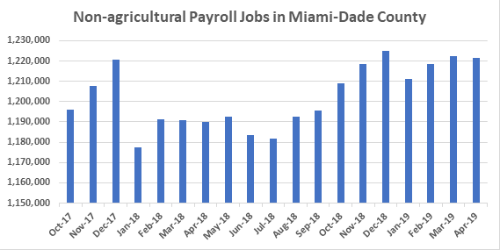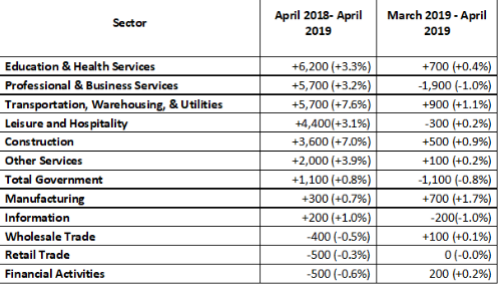In April 2019, Miami-Dade County area was the second largest metro area in year-over-year job gains in Florida, following the Orlando-Kissimmee-Sanford area. The County created 27,800 new non-agricultural payroll jobs (not seasonally-adjusted) from April 2018 to April 2019, which was a 2.3 percent increase. The jobs were created in different industries with the highest job creation occurring in Education & Health Services (6,200), Professional & Business Services (5,700), Transportation, Warehousing & Utilities (5,700), Leisure and Hospitality (4,400), Construction (3,600) Other Services (2,000), and Total Government (1,100). The graphs below show the payroll data since October 2017.

 The not seasonally adjusted unemployment rate for Miami-Dade County was 3.0 in April 2019. Compared to last April there was a 1.2 percentage point decrease in unemployment rate at (4.2 percent in April 2018). Compared to March 2019 there was a 0.4 percentage point decrease from the unemployment rate of 3.4 percent. The graph below compares the unemployment rate for Miami-Dade County with that of the United States since October 2017. It shows that Miami-Dade County was tracking the unemployment rate of the United States at a slightly higher rate until November 2018. For the last five months The United States has had a higher unemployment rate than Miami-Dade County.
The not seasonally adjusted unemployment rate for Miami-Dade County was 3.0 in April 2019. Compared to last April there was a 1.2 percentage point decrease in unemployment rate at (4.2 percent in April 2018). Compared to March 2019 there was a 0.4 percentage point decrease from the unemployment rate of 3.4 percent. The graph below compares the unemployment rate for Miami-Dade County with that of the United States since October 2017. It shows that Miami-Dade County was tracking the unemployment rate of the United States at a slightly higher rate until November 2018. For the last five months The United States has had a higher unemployment rate than Miami-Dade County.
 In April 2019, the seasonally adjusted unemployment rate for Miami-Dade County (taking seasonal fluctuations in the labor force into consideration) was 3.4 percent, which was 0.3 percentage points lower than in April 2018.
In April 2019, the seasonally adjusted unemployment rate for Miami-Dade County (taking seasonal fluctuations in the labor force into consideration) was 3.4 percent, which was 0.3 percentage points lower than in April 2018.
 From the data and analysis above, we see continued improvement in the local economy. Nevertheless, the community needs to remain focused on job-creation projects in targeted industries. These industries have been identified as the sectors where Miami-Dade County is best able to create additional well-paying job opportunities, leading to an improved quality of life for Miami-Dade County residents. The Miami-Dade Beacon Council continues to aggressively work on attracting new companies to our community, and works on the expansion and retention of existing business. For more information, visit www.beaconcouncil.com.
From the data and analysis above, we see continued improvement in the local economy. Nevertheless, the community needs to remain focused on job-creation projects in targeted industries. These industries have been identified as the sectors where Miami-Dade County is best able to create additional well-paying job opportunities, leading to an improved quality of life for Miami-Dade County residents. The Miami-Dade Beacon Council continues to aggressively work on attracting new companies to our community, and works on the expansion and retention of existing business. For more information, visit www.beaconcouncil.com.
The job creation numbers are derived from the U.S. Bureau of Labor Statistics Current Employment Statistics Program (CES), and only account for non-farm payroll jobs. However, the unemployment rates are derived from the U.S. Bureau of Labor Statistics Local Area Unemployment Statistics Program (LAUS), which includes farm payroll jobs as well as self-employed workers. In addition, the federal government typically conducts interviews in sample households to determine the unemployment rate. Miami-Dade County is one of six metropolitan areas in the United States that uses a different method solely based on a statistical model derived from several data sets.


